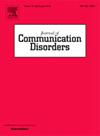单词学习的动态评估可预测对词汇干预的反应
IF 2.1
3区 医学
Q2 AUDIOLOGY & SPEECH-LANGUAGE PATHOLOGY
引用次数: 0
摘要
导言:本研究探讨了词汇和单词学习的静态和动态测量在多大程度上可以预测对词汇干预的反应并识别反应不佳者。儿童在干预前接受了词汇知识的静态测量和显性词汇学习的动态评估。结果静态测量和动态测量都能显著预测干预后的词汇学习情况。单独的动态评估可预测词汇学习差异的 25%;静态和动态测量相结合可预测 42%。在反应性分析中,动态测量法提供了单一测量法的最佳准确性(76%),但静态和动态测量法组合提供了最准确的分类(79%)。 结论在这项研究中,静态和动态测量法都能预测学龄前儿童对词汇干预的反应,并对反应好和反应差的儿童提供了基本准确的分类。更多的研究可以为使用动态评估来预测干预反应和为儿童匹配强化干预提供信息。本文章由计算机程序翻译,如有差异,请以英文原文为准。
Dynamic assessment of word learning as a predictor of response to vocabulary intervention
Introduction
The current study examined the extent to which static and dynamic measures of vocabulary and word learning predicted response and identified poor responders to a vocabulary intervention.
Methods
Participants were 46 preschool children in classrooms randomly assigned to complete the Story Friends intervention in two cluster-randomized efficacy trials. Children were administered a static measure of vocabulary knowledge and a dynamic assessment of explicit word learning prior to intervention. Vocabulary learning in response to intervention was assessed using a curriculum-based definitional task.
Results
Both the static and dynamic measures were significant predictors of vocabulary learning in response to intervention. The dynamic assessment alone predicted 25 % of variance in vocabulary learning; the static and dynamic measures in combination predicted 42 %. In the responsivity analysis, the dynamic measure provided the best accuracy for a single measure (76 %), but the most accurate classification was provided by a combination of static and dynamic measures (79. The static measure accurately identified 93 % of poor responders, whereas the dynamic measure accurately identified 88 %.
Conclusions
In this study, both static and dynamic measures predicted preschool children's response to vocabulary intervention and provided a mostly accurate classification of good and poor responders. Additional research can inform the use of dynamic assessment to predict response to intervention and to match children with intense interventions.
求助全文
通过发布文献求助,成功后即可免费获取论文全文。
去求助
来源期刊

Journal of Communication Disorders
AUDIOLOGY & SPEECH-LANGUAGE PATHOLOGY-REHABILITATION
CiteScore
3.30
自引率
5.90%
发文量
71
审稿时长
>12 weeks
期刊介绍:
The Journal of Communication Disorders publishes original articles on topics related to disorders of speech, language and hearing. Authors are encouraged to submit reports of experimental or descriptive investigations (research articles), review articles, tutorials or discussion papers, or letters to the editor ("short communications"). Please note that we do not accept case studies unless they conform to the principles of single-subject experimental design. Special issues are published periodically on timely and clinically relevant topics.
 求助内容:
求助内容: 应助结果提醒方式:
应助结果提醒方式:


